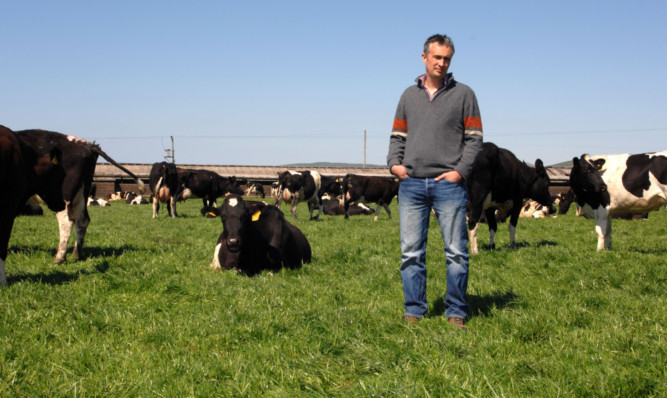Dairy farmers who have seen the price of milk drop in recent months have been advised to look beyond this short-term fall in value and concentrate on building good long-term relationships with their processors.
South-west of Scotland farmer Rory Christie, of Dourie, Port William, was speaking at an open day on his farm where he milks 1,500 Jersey cross Friesian cows.
He said he was putting his faith in milk solids production, and growth in that market should not be feared.
“I think it is important not to get carried away with short-term fluctuations in the market, and instead we should be looking at long-term prospects.
“There are opportunities out there and we should be taking them.”
In his part of the world there are few, if any, contracts for fresh milk and he has spent a considerable amount of time building up a trading relationship with local processors Lactalis a French family-owned business which is number one cheese-maker in Europe and which 10 years ago took over the McLelland cheese business.
Mr Christie also said he believed the message given out exactly a year ago by James Withers, the author of a report into the future of the Scottish dairy industry, was correct and that expansion is possible, especially if it majored on the provenance of Scottish dairy produce.
“We want to be competitive, but we do not want to be competing at the lower end of the market; that would be very difficult.
“We want to work with our processors and develop brands which give us an edge in the marketplace.”
He believed the Scottish dairy industry had turned the corner, with eight new dairies being established on farms this year the first time in living memory this has happened.
Also, existing producers were increasing their cow numbers, thus giving economies of scale.
He did not see any economic benefit could come from limiting the number of cows an individual producer could keep, saying all that would do would be to give market share to competitors.
Also speaking at the event, George Jamieson, milk policy adviser with the union, said current milk prices were the result of a “perfect storm” in which major players such as China had helped overheat the market then allowed it to collapse.
He also said good weather had prevailed right across the milk-producing countries in the world. Milk yields were up considerably as a result, putting downward pressure on the market.
He produced graphs showing that, while the present price drop was quite dramatic, the overall trend in price was upward and that for at least the next two years the prospects looked good for dairy produce.
When questioned on a future threat from Ireland, where dairy farmers have threatened to double their production, he said he believed the primary target for Irish dairy produce would be the developing market in Africa.
He rejected criticism of the union for its support of an increase in home production, saying that provided on-farm expansion was linked to processing opportunities opening up, the benefits would come right along the food chain.
“Processors will only come here if they see production rising,” he said.
“They will not spend money setting up plants where they see producers leaving the industry.”
